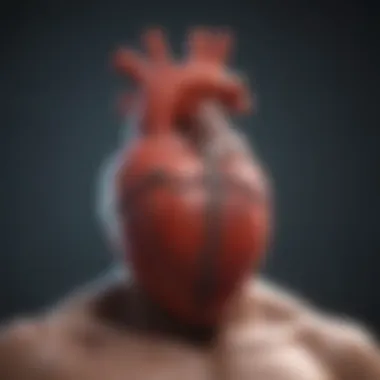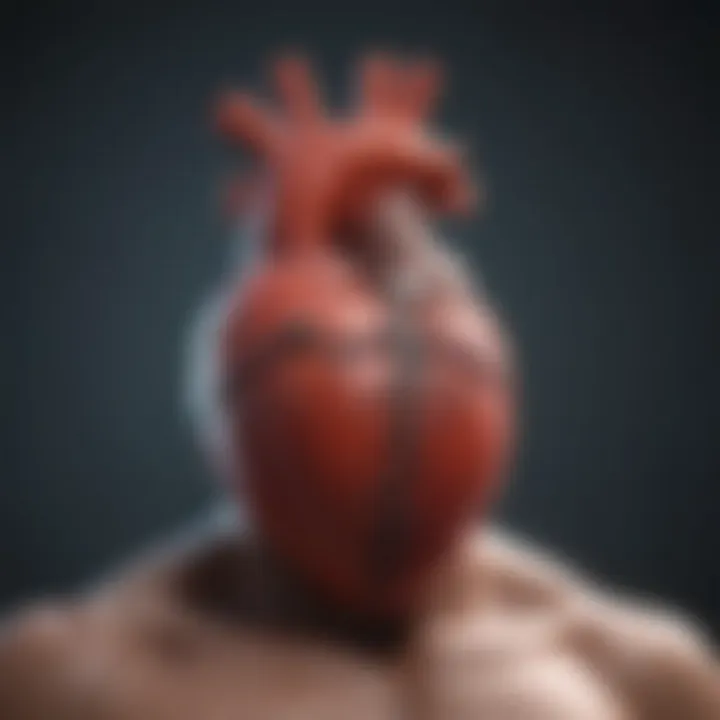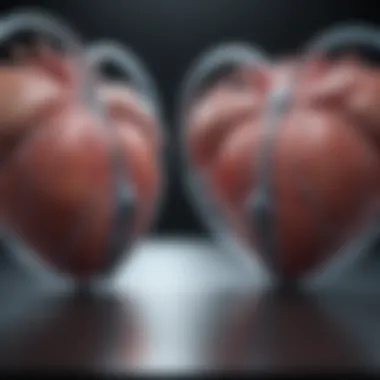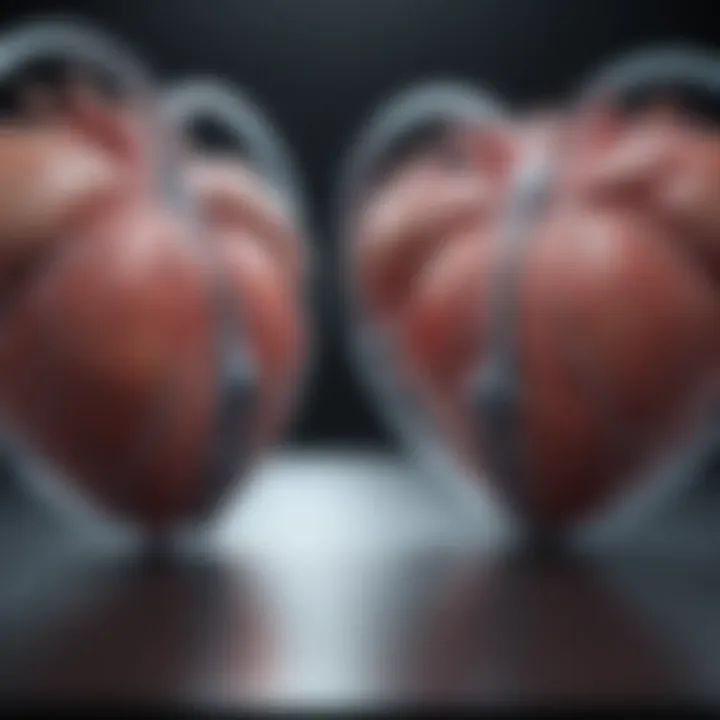Milestones in Heart Transplantation History


Intro
Cardiac transplantation marks a pivotal advancement in medicine, altering the landscape of treatment for end-stage heart disease. The journey began with the world's first successful heart transplant, executed by Dr. Christiaan Barnard in 1967. This significant milestone did not merely introduce a surgical technique; it initiated a profound transformation in medical practices and ethical considerations surrounding transplant medicine.
Understanding this evolution is essential for medical professionals, students, and researchers alike. Insights gained from past successes and challenges provide a roadmap for future innovations, helping to address ongoing issues in cardiac surgery and transplantology.
The significance of this field extends beyond clinical practice. Ethical dilemmas, technological limitations, and societal impacts intertwine to shape the current conversation around heart transplantation. This exploration thus seeks to unravel these complex layers, providing a comprehensive examination of the remarkable milestones that define the trajectory of cardiac transplantation.
As we delve into key events and innovations that have influenced this field, we will outline critical findings and perspectives. The article aims to be a resource for those looking to deepen their understanding of cardiac transplantation and its lasting implications on modern medicine.
Preface to Heart Transplantation
Heart transplantation represents a significant advance in medical science, offering a solution for patients suffering from severe heart disease. As the leading cause of death globally, heart conditions severely impact quality of life. Heart transplantation not only restores life but also improves the overall health of individuals facing terminal cardiac ailments. It alleviates symptoms associated with heart failure and enhances life expectancy, making this procedure invaluable.
In this section, we will examine the definition and purpose of heart transplantation, along with its historical significance. Understanding these aspects provides necessary context for later discussions on surgical techniques, advancements, and ethical considerations.
Definition and Purpose
At its core, heart transplantation involves replacing a diseased or failing heart with a healthy heart from a deceased donor. The primary aim is to provide a functioning heart to patients whose own hearts are not able to sustain life due to various ailments, such as cardiomyopathy or severe coronary artery disease. This surgery is typically considered when other treatments, like medications or less invasive surgeries, have failed.
The purpose of heart transplantation extends beyond mere survival. For many recipients, it represents hope for a new lease on life, a chance to engage in normal activities that heart disease had previously made impossible. This procedure requires a meticulous evaluation process, ensuring that only suitable candidates are selected. Factors such as overall health, age, and the presence of other medical conditions can determine eligibility.
The complexity of the procedure necessitates considerable resources and expertise, underlining its importance in the medical landscape.
Historical Significance
The history of heart transplantation is marked by groundbreaking innovations and audacious attempts to solve one of humanity's most pressing health crises. Prior to the late 20th century, the notion of successfully transplanting human organs was largely theoretical. Early experiments in organ transplantation faced numerous challenges, including rejection, infection, and lack of understanding regarding surgical techniques.
The first successful heart transplant performed by Dr. Christiaan Barnard in 1967 was a pivotal moment. It showcased not just the possibilities of surgical excellence but also the advancements in immunosuppressive therapies, which would allow the body to accept a foreign organ. This milestone not only impacted cardiac surgery but also influenced organ transplantation across all fields of medicine.
The procedural evolution that followed Barnard's surgery has been significant. Advances in surgical techniques and postoperative care now yield much higher success rates. Over time, heart transplantation has shifted from a last resort to a viable option for many patients with end-stage heart disease, reflecting broader improvements in surgical practice.
The Genesis of Cardiac Surgery
The development of cardiac surgery marks a pivotal chapter in medical history. This field has evolved significantly over time, reflecting advances not only in technology but also in the understanding of cardiac function and pathology. This evolution is crucial, as it set the stage for heart transplantation and the subsequent innovations that have marked this specialty. Cardiac surgery is distinguished by its critical role in addressing life-threatening conditions. Components such as surgical techniques, patient management, and interdisciplinary collaboration have become indispensable elements in cardiac care.
Early Innovations in Surgery
The origins of cardiac surgery can be traced back to the late 19th and early 20th centuries. Initial attempts were rudimentary, focusing on methods to address external injuries to the heart. Pioneers like Dr. Ludwig Rehn performed the first successful closure of a stab wound to the heart in 1896. This marked an important milestone, showcasing the possibility of surgical intervention on the heart, even if under very limited circumstances.
Following this, advancements continued steadily. The success of techniques such as direct aortic repair in the early 20th century was instrumental. Innovations in anesthesia and sterile techniques allowed for more complex surgeries. Noteworthy contributions came from figures such as Dr. Robert Gross, who successfully repaired a congenital heart defect in 1938. These early successes forged a path that established a functional understanding and confidence in cardiac procedures.
The Role of Surgical Pioneers
Surgical pioneers have always been at the forefront of cardiac surgery. Their contributions have not only advanced surgical techniques but also redefined the role of the surgeon in patient care. Surgeons like Dr. Alfred Blalock and Dr. Helen Taussig played crucial roles in developing procedures that saved countless lives.
The creation of the Blalock-Taussig shunt in the early 1940s is a prominent example. This procedure increased blood flow to the lungs for children with cyanotic congenital heart defects. The collaboration between surgeons and physicians showcased the importance of interdisciplinary strategies in achieving successful patient outcomes.
Moreover, as knowledge of cardiac physiology advanced, so did the complexity of procedures. The introduction of cardiopulmonary bypass in the 1950s by Dr. John Gibbon enabled surgeons to operate on a still and bloodless heart, pushing the boundaries of what was possible in this field.
"The heart is a self-healing organ. Every surgical intervention must respect its intrinsic capacity for recovery and adapt to its unique physiology.”
In summary, the genesis of cardiac surgery represents a confluence of innovation, courage, and collaboration. This foundation paved the way for subsequent developments, leading to revolutionary procedures such as heart transplantation. Each success in early surgery built upon the last, leading to improved techniques and a deeper understanding of cardiovascular health. These milestones set a precedent that continues to influence cardiac care today.
Dr. Christiaan Barnard: Key Figure in Transplant History
Dr. Christiaan Barnard stands as a pivotal figure in the domain of cardiac transplantation. His contributions have not only changed the medical landscape but also challenged the existing paradigms regarding organ donation and surgeries. Barnard's efforts led to the first successful human heart transplant on December 3, 1967. This surgery marked a significant leap, paving the way for future research and advancements in transplant technology.
Barnard’s pioneering work also came with many challenges. At a time when heart transplantation was largely experimental, he faced skepticism from mainstream medicine. Nonetheless, his determination and perseverance ultimately laid the groundwork for modern transplantation techniques. The implications of his work extended beyond the operating room, sparking discussions on ethics, organ allocation, and patient rights.
Background and Education
Christiaan Neethling Barnard was born in 1922 in the small town of Beaufort West, South Africa. He pursued his medical degree at the University of Cape Town, demonstrating significant academic prowess. He later furthered his education in surgery, taking his talents to the United States where he studied at the University of Minnesota, gaining valuable insights and experience in cardiac surgery.
Although Barnard’s academic journey was not without difficulties, his education equipped him with groundbreaking knowledge in surgical techniques. He witnessed and learned from leading surgeons, which influenced his later practices. This international exposure allowed him to merge innovative ideas with established medical practices. After returning to South Africa, he became a prominent cardiac surgeon at Groote Schuur Hospital, where he would eventually perform his historical transplant.
Motivations for Cardiac Transplantation
The motivations behind Barnard's groundbreaking endeavor to perform heart transplantation were multifaceted. Primarily, he aimed to address the dire need for effective treatments for patients suffering from severe heart disease. Both personal experience and professional interactions heightened his awareness of patients' suffering and limited surgical options.
Barnard was inspired by the advances in mechanical support and the concept of organ donation. He recognized that artificial devices could temporarily assist failing hearts, yet they were not a long-term solution. He believed that the human heart, being a vital organ, required a more definitive remedy, which led him to explore the possibility of transplantation.


"We must be willing to take risks if we are to save lives and advance medicine."
Barnard's motivations also encompassed a strong commitment to medical innovation. He understood that every major advance in medicine began with a willingness to challenge status quo. His vision was not just confined to surgical success; he wanted to foster a new era in which cardiac transplantation could be a legitimate treatment for end-stage heart disease.
The First Heart Transplant: A Medical Milestone
The first heart transplant marked a pivotal moment in the field of medicine. Conducted by Dr. Christiaan Barnard in 1967, this operation opened the door to new possibilities in cardiac care. Before this, patients with end-stage heart diseases had limited options. They often faced a grim prognosis with very few avenues for treatment. The landmark nature of this transplant redefined the boundaries of medical science and laid the groundwork for future advancements in organ transplantation.
This operation was not solely about the surgical act. It was a culmination of years of research, technological advancements, and ethical considerations. In the context of medical history, it showed how far surgery had come and the potential of organ donation. This accomplishment paved the way for transplant programs around the world and changed how we perceive organ failures.
The Surgical Procedure
The surgical procedure for the first heart transplant was complex and fraught with challenges. On December 3, 1967, Dr. Christiaan Barnard performed the operation at Groote Schuur Hospital in Cape Town, South Africa. The patient, Louis Washkansky, was suffering from severe heart disease and had little hope of survival without this drastic intervention.
The process involved removing the diseased heart and replacing it with a donor heart. This required precise surgical skill and experience. Operating under high stakes, the team had to ensure that the new heart was adequately matched for size and function. Despite the daunting nature of the procedure, it was successful, although this does not negate the inherent risks. Among the critical technical elements were:
- Cardiac arrest: The patient's heart must be stopped to perform the transplant.
- Preservation of the donor heart: Keeping the donor heart viable before implantation is essential to its success.
- Anastomosis: The reattachment of blood vessels must be done meticulously to prevent complications.
This procedure set a precedent, influencing countless other cardiac surgeries. It instilled hope for patients with no options previously.
Recipient's Profile and Prognosis
After the surgery, Louis Washkansky's profile reflected a story of bravery and newfound life. He was a 53-year-old man whose health situation prior to the transplant seemed dire. His diagnosis pointed toward the end of his life without intervention. After receiving the heart of a young donor, his recovery was momentous, and he lived for another 18 days before passing due to pneumonia. This outcome raised discussions regarding the post-transplant prognosis and potential complications.
Louis's case spotlighted several important factors influencing prognosis:
- Immune response: The risk of rejection by the recipient’s body remains the most significant concern in all transplants.
- Post-operative care: Adequate monitoring and medication are vital.
- Psychological factors: The emotional state of patients can influence recovery and adaptation to the new organ.
This pioneering effort pushed the boundaries of transplantation and contributed to refining what we know today about heart transplants. The first heart transplant was more than a technical achievement; it was the beginning of a new era in cardiology and organ transplantation, shaping the future for countless patients.
Technological Advancements in Organ Transplantation
Technological advancements have played a crucial role in enhancing the success and efficiency of organ transplantation. The evolution of cardiac transplantation is marked by significant innovations that have transformed both surgical techniques and post-operative care. In the realm of heart transplants, these advancements ensure higher survival rates and improved quality of life for patients.
One of the critical areas of focus is the development of immunosuppressive therapies. These therapies are designed to suppress the immune system's response to foreign organs, minimizing the risk of rejection. Early heart transplant recipients faced high rejection rates due to their body's natural defenses. With the introduction of drugs like cyclosporine in the 1980s, doctors could reduce organ rejection significantly. Currently, protocols often combine multiple immunosuppressive agents to achieve a delicate balance between preventing rejection and managing potential side effects.
Immunosuppressive Therapies
Immunosuppressive therapies have fundamentally changed the landscape of cardiac transplantation. Initially, patients required high doses of medications, leading to severe side effects. However, modern advances focus on targeted therapies, improving safety and efficacy. For instance:
- Calcineurin inhibitors: These remain a cornerstone of transplant immunosuppression, effectively preventing rejection.
- mTOR inhibitors: These newer agents offer an alternative, targeting different pathways to suppress immune response.
- Induction therapy: In many cases, patients receive high-dose immunosuppression at the time of transplant to further reduce rejection risk.
The selection and management of these therapies require thoughtful consideration from medical professionals. Patient-specific factors like age, existing health conditions, and potential drug interactions must be carefully evaluated to optimize outcomes.
Surgical Techniques and Instrumentation
Advancements in surgical techniques and instrumentation have also been paramount in the evolution of heart transplantation. Surgeons have developed increasingly sophisticated methods that enhance precision and minimize trauma during operations. Key advancements include:
- Video-assisted thoracoscopic surgery (VATS): This minimally invasive approach reduces recovery time and post-operative pain compared to traditional methods.
- Robotic surgery: Incorporating robotic systems allows surgeons to perform complex procedures with enhanced dexterity and precision, potentially reducing complications.
- Improved surgical instruments: Modern tools, including advanced suturing devices and grafting materials, facilitate a more efficient surgical process, contributing to improved patient outcomes.
These innovations have led to shorter hospital stays, lower rates of complications, and overall better quality of care.
"The advances in surgical techniques and immunosuppressive therapies continue to push the boundaries of what is possible in organ transplantation, transforming once challenging procedures into routine practices."
The continuation of research and development in these areas holds promise for the future of heart transplantation. As new technologies emerge, they not only reshape surgical practice but also improve the overall transplant experience for patients, paving the way for more successful long-term outcomes.
Ethical Considerations in Heart Transplantation
The field of heart transplantation poses various ethical questions that impact patients, healthcare providers, and society as a whole. Understanding these ethical considerations is crucial in ensuring that the process is deemed both morally and legally acceptable. The complexity surrounding organ donation and transplantation involves numerous factors from donor selection to patient rights. As such, making informed and ethical decisions can potentially lead to better outcomes and public trust in medical practices.
Donor Selection and Allocation
The selection and allocation of donor organs often present challenging ethical dilemmas. The procedure requires a fair and transparent system to match available organs with recipients. Generally, factors impacting donor selection include medical history, the suitability of the organ, and the urgency of the recipient's condition. Additionally, geographical location and the logistical capability to transplant organs significantly matter in this process. When selecting donors, transplant teams must also consider the potential benefits to the recipient while minimizing harm.
A few critical aspects in donor selection and allocation include:
- Equity: The principle of fairness demands that no group should receive preferential treatment over others.
- Medical urgency: A balanced consideration must be given to patients who are in critical need of a heart transplant versus those for whom the surgery is less urgent.
- Social factors: Although less tangible, societal benefits and the recipient's background may also factor into decision-making.
Evaluating all these factors critically can foster equitable access to life-saving heart transplants. The goal is to promote a just system that respects the dignity of both donors and recipients.
Patient Consent and Autonomy


Patient consent is equally essential when discussing ethical considerations in heart transplantation. Informed consent involves ensuring that patients understand the risks, benefits, and alternatives related to the surgery. It is vital for both donors and recipients to give clear and voluntary consent, free from coercion.
Moreover, patient autonomy forms the backbone of ethical medical practice. Each individual should retain the right to make decisions about their health care. For organ donors, this means having the freedom to refuse donation, while for recipients, it encompasses the power to accept or decline a transplant.
Key points regarding patient consent and autonomy include:
- Communication: Clear communication between healthcare providers and patients helps clarify roles and expectations.
- Informed choices: Patients should be provided with comprehensive information regarding their condition and the transplant process.
- Support systems: Encouraging support from family and friends can lead to better informed decisions.
"Informed consent is fundamental to respect patient autonomy and ensure ethical transplantation practices."
Through respect for patient autonomy and clear guidelines on consent, healthcare systems can enhance the legitimacy of heart transplantation practices. This approach can significantly contribute to building trust in medical interventions and practices while highlighting an ethic-centered culture within healthcare.
Evolution of Cardiac Transplantation Techniques
The advancement of cardiac transplantation techniques marks a pivotal shift in cardiac surgery and patient care. This evolution is crucial not just for improving survival rates after transplantation but also for enhancing the overall quality of life for patients. Over the decades, the methodologies have transitioned from rudimentary practices to sophisticated, evidence-based approaches. Understanding this evolution provides insight into the future of cardiac interventions and raises awareness about ongoing challenges in the field.
From Standard Techniques to Innovative Methods
Standard methods of cardiac transplantation have evolved significantly since the initial procedures conducted in the late 20th century. Early surgeries predominantly focused on the rudimentary principles of transplantation, with the primary goal being to replace a diseased heart. These traditional techniques often resulted in extended recovery times and higher risks of complications.
The introduction of innovative methods changed the landscape dramatically. Surgeons, inspired by technological advancements, began adopting techniques that minimized tissue damage and reduced operative stress. For instance, the use of techniques such as rigorous tissue matching and advanced cardiopulmonary bypass systems has become standard practice. Moreover, these innovations allow for more precise donor heart retrieval and implantation, significantly reducing complications related to ischemia.
"The transformation from standard to innovative methods has been a game-changer in cardiac transplantation, profoundly influencing outcomes and patient experiences."
The initiative to refine methods also includes the adoption of robotic surgery and laparoscopic techniques. These options provide less invasive solutions to traditional surgeries, allowing for smaller incisions, reduced pain, and shorter recuperation times. With these advancements, the risk factors associated with surgery are more manageable, leading to improved survival rates.
Minimally Invasive Approaches
Minimally invasive approaches represent the forefront of cardiac transplant methodologies. The growing focus on reducing the physical strain on patients has prompted surgeons to adopt techniques that do not require large incisions. Instead, smaller openings utilized during surgery allow for greater precision and reduced recovery time.
Some of the critical advancements in minimally invasive heart transplantation include:
- Video-Assisted Techniques: Utilizing cameras and monitors enables surgeons to visualize the surgical site without extensive incisions.
- Transcatheter Approaches: These methods allow for the performance of procedures through blood vessels, leading to smaller wounds and faster recovery.
- Endoscopic Procedures: Endoscopy offers a less invasive means of accessing the heart and surrounding structures, minimizing patient trauma.
The impact of these minimally invasive methods cannot be overstated. They have led to decreased hospital stays, lower healthcare costs, and an overall enhancement of the patient's postoperative experience. Patients report less pain, faster return to normal activities, and improved psychological well-being.
In summary, the evolution of cardiac transplantation techniques signifies an ongoing commitment to enhancing patient care. The shift from standard to innovative methods and the rise of minimally invasive practices illustrate the adaptability of the medical field in response to technological advancements and patient needs.
Long-term Outcomes of Heart Transplants
Long-term outcomes of heart transplants play a vital role in understanding the success and impact of this life-saving procedure. Patients who receive a heart transplant often have severe and life-threatening cardiac conditions, making the effectiveness of the operation paramount. The significance lies not only in extending life but also in enhancing the quality of life to enable a meaningful existence post-surgery.
Survival Rates and Factors Influencing Success
Survival rates following heart transplants have shown notable improvement over the decades. Currently, data indicates that the average survival rate at one year after transplant ranges from 85% to 90%, depending on various factors such as the patient's overall health, age, and the underlying cause of heart failure.
Several factors influence success rates:
- Patient Selection: Careful selection of recipients based on their medical history can dramatically alter outcomes. Older patients or those with comorbid conditions may face higher risks.
- Donor Quality: The characteristics of the donor heart, including age and health status, can directly affect graft survival. Better matches typically result in better outcomes.
- Immunosuppression Regimen: Appropriate use of immunosuppressants is crucial to prevent organ rejection while balancing infection risks.
Statistically, approximately 50% of heart transplant recipients can expect to live 10 years or more after surgery, a notable achievement compared to previous eras of transplantation. This progress is a result of advancements in surgical techniques, post-operative care, and medical therapies developed to manage transplant patients.
"The survival rates continue to improve as a testament to medical advancements in heart transplantation and patient care involved in the process."
Quality of Life Post-Transplant
Beyond survival rates, the quality of life post-transplant is an equally important aspect of long-term outcomes. Recipients often experience significant improvements in daily functioning and overall wellbeing. Many patients return to normal activities, including work and exercise, which contributes to a more fulfilling life.
Key aspects affecting quality of life include:
- Physical Health: With proper adherence to medical regimens, many patients report increased energy levels and reduced symptoms of heart failure.
- Emotional Wellbeing: Life after a transplant can bring about psychological challenges. Support systems, including counseling and community support, play a crucial role in helping patients adjust emotionally.
- Lifestyle Changes: Patients often adopt healthier habits, such as improved diet and regular exercise. These changes enhance overall health and reduce the risk of complications.
The integration of a support network and education on lifestyle management can greatly influence the satisfaction and overall health of heart transplant recipients. Focus on promoting awareness about the importance of transplantation and the possibility of a good quality of life is essential.
Future Directions in Heart Transplant Research
The field of heart transplantation is on the cusp of significant advancements. As we look toward the future, it is crucial to explore areas that promise to enhance patient outcomes and refine existing practices. The research in heart transplantation continues to evolve, driven by both technological advancements and the pressing need to improve the lives of patients with heart failures. This section delves into the potential developments in regenerative medicine and bioengineering, both of which hold substantial promise for the future of cardiac transplant practices.
Regenerative Medicine and Stem Cells
Regenerative medicine seeks to restore the normal function of damaged tissues or organs. In the context of heart transplantation, stem cell research offers exciting possibilities. There are several key benefits associated with this direction of research:


- Tissue Regeneration: Stem cells have the capability to differentiate into various cell types. This means that they can potentially replace damaged heart tissue, offering a solution not just for transplant recipients but also for individuals who face heart ailments without the need for organ donation.
- Reduced Rejection Rates: By using a patient’s own stem cells, it is possible to mitigate the risk of organ rejection. This could lead to more personalized transplant options, aligning with the growing trend of customized medicine.
- Improved Postoperative Recovery: Stem cell therapies could lessen the complications often associated with traditional transplants, potentially resulting in quicker recovery times and better overall outcomes.
Current research is focusing on methods to effectively harvest, differentiate, and inject stem cells into the heart. As studies progress, the hope is that regenerative techniques will become standard practice in conjunction with traditional heart transplantation approaches.
Bioengineering of Organs
Bioengineering of organs represents another promising frontier in heart transplantation. This area utilizes cutting-edge technology, including 3D printing and tissue engineering, to create bioengineered hearts or heart components. Some specific aspects to consider include:
- Customizability: 3D printing allows for the production of hearts tailored to individual anatomy and physiology. This personalization can improve integration and function in the body.
- Decreased Waiting Times: The ability to bioengineer organs means that patients may no longer have to wait for a suitable donor. This can save lives and substantially improve outcomes.
- Elimination of Rejection: Like regenerative approaches, bioengineered organs may use the recipient's own cells, potentially minimizing immune system rejection.
Ongoing advancements in bioengineering could lead to fully functional artificial hearts, which might one day serve as permanent solutions for patients who cannot receive traditional transplants.
Public Perception and Awareness
Public perception and awareness are paramount in the realm of cardiac transplantation. Understanding how society views heart transplants can significantly influence donor registration rates, patient support, and overall health policies. As this medical procedure involves life-and-death decisions, it is essential for the public to possess accurate information about the process, its implications, and its outcomes.
One of the primary challenges in shaping public perception is the presence of myths and misconceptions about heart transplantation. Misinformation can foster fear and hesitance among potential organ donors and recipients. When people believe in inaccuracies, it can impede their willingness to engage with the transplant system. For example, many individuals may think that if they register as organ donors, they could receive inadequate medical care in emergencies. This is simply not true; medical professionals prioritize saving lives above all.
Transplant Myths and Misconceptions
Several myths surround the topic of heart transplantation which need to be addressed to promote a better understanding:
- Myth 1: Only older people receive heart transplants. People of various ages can be eligible for heart transplants. Age alone is not a determining factor in the organ allocation process.
- Myth 2: Organ donation is dangerous for the donor. The process of organ donation is highly regulated and includes numerous medical evaluations to ensure safety for the donor, particularly in living donations where applicable.
- Myth 3: Recipients will not survive long after a transplant. Survival rates have significantly improved over the years. Many recipients can live healthy lives long after surgery, thanks to advancements in immunosuppressive therapies.
Dispelling these myths is crucial for encouraging people to consider organ donation seriously, which has far-reaching effects on the transplantation system.
Encouraging Organ Donation
Encouraging organ donation is essential for addressing the gap between supply and demand in heart transplantation. Public campaigns can educate individuals on the significance of organ donation and how it saves lives. Several strategies can be employed to raise awareness and foster a culture of donation:
- Educational Initiatives: Schools and community organizations can host workshops about the importance of organ donation and provide clear, factual information.
- Engagement with Healthcare Professionals: Healthcare providers can initiate discussions with patients about their choices regarding organ donation during routine medical visits.
- Utilization of Media: Social media platforms, such as Facebook and Reddit, can be powerful tools to spread awareness. Sharing personal stories from organ donors and recipients can make the subject relatable and inspiring.
The combination of education, personal stories, and engagement can create a more informed society that recognizes the value of organ donation.
Global Practices in Heart Transplantation
Understanding global practices in heart transplantation is crucial to recognize how various countries manage this complex procedure. Each nation has its own approach, shaped by cultural, social, and medical frameworks. The practice varies significantly across regions, impacting the accessibility and effectiveness of heart transplant programs.
The impact of globalization on heart transplantation is quite significant. This allows for sharing of best practices and innovative techniques. When countries collaborate on research and share surgical data or outcomes, the entire field benefits. Such cross-border synergies can lead to improved transplantation protocols and outcomes for patients worldwide.
Further examination of the ethical frameworks and healthcare policies surrounding organ donation can clarify challenges that transplant programs face globally. In some countries, higher rates of organ donation correlate with effective public awareness campaigns. This is an important aspect to study. Countries with structured education on the importance of organ donation tend to have more successful transplantation rates.
Case Studies from Different Countries
A closer look at specific case studies offers rich insights. For instance, Spain has become a model for organ donation. Their national program emphasizes public participation and awareness, resulting in a donor rate that outpaces many nations. By understanding Spain's methodology, other countries can adopt similar initiatives to improve their own donor rates.
In contrast, Japan's approach is constrained by cultural perspectives on death and organ donation, leading to fewer transplants. Reflecting on this provides necessary context for understanding global disparities in transplantation outcomes. Each case study can reveal unique practices that shape a country's transplantation success.
"The success of heart transplantation worldwide is not solely dependent on medical competencies but also on the societies' readiness to embrace organ donation."
Regulatory Frameworks and Guidelines
Regulatory frameworks play a key role in heart transplantation. Different countries have established their own guidelines on donor selection, allocation, and patient management, reflecting their social, medical, and ethical considerations. The standards may vary from one nation to another, but the underlying aim is the same: to save lives through effective heart transplantation.
Organizations such as the World Health Organization (WHO) provide guidelines that help standardize practices on a global scale. These guidelines influence national laws and ethical considerations regarding organ donation and transplantation.
National programs, like those in the United States, focus on the definition of brain death, ethical allocation of organs, and monitoring post-transplant care. In Europe, protocols may emphasize transparency in organ allocation and patient prioritization, influenced by public sentiment towards healthcare and organ donation.
By examining these regulatory practices, one can grasp how they directly impact the success and sustainability of heart transplantation programs. This knowledge is valuable for students and professionals aiming to contribute to the evolution of transplant medicine.
Epilogue: The Legacy of Heart Transplantation
In the field of medicine, heart transplantation stands as a testament to human ingenuity and resilience. The legacy left by pioneers like Dr. Christiaan Barnard extends beyond the confines of the operating room; it has shaped not only surgical practices but also the ethical landscape surrounding organ donation and transplantation. This procedure, once deemed impossible, now offers a lifeline to patients with end-stage heart failure. The journey from early skepticism to acceptance reflects ongoing advancements in both surgical techniques and immunosuppressive therapies.
Reflection on Historical Milestones
Reflecting on key historical milestones, one sees a pattern of relentless pursuit of knowledge and innovation. 1967 was pivotal; it was the year Dr. Barnard successfully performed the first human heart transplant in South Africa. This groundbreaking event marked a shift in medical possibility, prompting further research into organ transplantation. Subsequent years saw the development of potent immunosuppressive medications. Drugs like azathioprine and cyclosporine expanded the horizons for transplant longevity.
These milestones, however, were coupled with challenges. Early recipients faced significant risks of rejection and complications, leading to a high rate of early failure. Yet, with perseverance, transplant teams developed protocols that improved outcomes substantially. For instance, the introduction of organ preservation techniques has significantly boosted transplant viability, allowing organs to remain functional longer before transplantation.
"Each milestone achieved in cardiac transplantation brings us closer to a future where heart failure may no longer be a death sentence."
Looking Ahead: Challenges and Opportunities
While the history of heart transplantation is filled with significant achievements, the path forward is equally complex. Researchers and healthcare professionals face numerous challenges, such as organ scarcity and the social stigma surrounding organ donation. Education campaigns are vital in combating misconceptions and encouraging voluntary donation. Increasing awareness could alleviate the ever-growing disparity between the number of available organs and the demand for them.
Furthermore, ongoing research into regenerative medicine and bioengineering presents exciting opportunities. Techniques utilizing stem cells may one day enable the creation of bioengineered hearts, potentially eliminating the need for donor organs altogether. As advancements in technology progress, the barriers to successful heart transplants can be reduced, thus improving patient outcomes.



